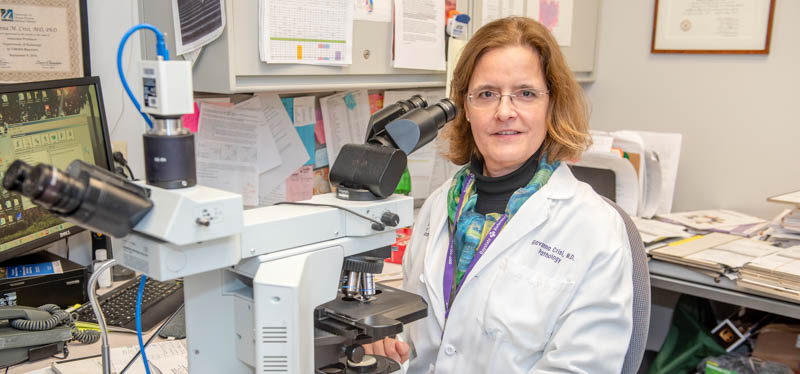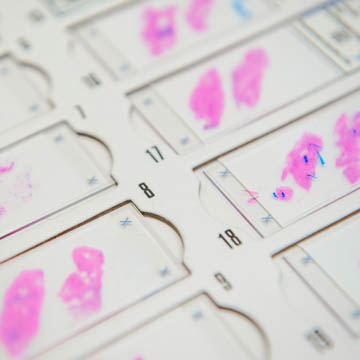
Dr. Giovanna Crisi, a breast pathologist at Baystate Health, was fascinated from a young age with the human body, biology, and how the organs within the body function.
Her interest in the human body led her to attend medical school. She completed her residency at Yale University in anatomic pathology, which looks at human disease on a cellular and molecular level, and later completed her fellowship at Hartford Hospital. A pathologist is a physician trained in the diagnosis of diseases – their causes, nature and effects – based on the biopsy of surgically removed organs, tissues, and bodily fluids.
Dr. Crisi’s passion about breast pathology came about while working toward her fellowship.
The work behind the scenes 
Numerous medical specialists, including surgeons, radiologists, oncologists, nurses and pathologists, are involved in a diagnosis of breast cancer and its treatment. As part of this multidisciplinary team, a breast pathologist such as Dr. Crisi plays a vital but invisible role to breast cancer patients.
“Because pathologists do not directly see patients, they are often unaware of our contributions to the diagnosis and treatment of breast cancer,” Dr. Crisi said.
Dr. Crisi explained the pathologist’s role in breast cancer treatment and diagnosis.
When a breast tumor or tissue has been biopsied, or removed from a patient, the pathologist prepares that breast tissue for microscopic evaluation. The preparation process may take up to 48 hours depending on the specimen type and complexity. The specimen is then placed on slides, which are reviewed by the pathologist under a microscope and documented in a surgical pathology report.
Making a diagnosis
Dr. Crisi noted a complete and accurate pathology report is crucial in getting a precise diagnosis and deciding the best treatment plan for the specific type of breast cancer.
“I am very passionate about my work as an anatomic pathologist. With a sharp eye and expertise in pattern recognition, I strive to resolve diagnostic challenges and provide a detailed and accurate diagnosis to the clinical team in order to provide the best care and outcomes for our patients,” Dr. Crisi said.
A pathologist diagnoses breast cancer and determines whether a tumor is benign or malignant. If the tumor is malignant, the pathologist will then size, grade, and determine margins (how far the tumor has grown into the breast tissue). The pathologist will also see whether it has spread to lymph nodes or other organs.
In tumors of the breast, a pathologist will also determine the type of proteins a tumor may express, such as estrogen receptor and HER-2. Their analysis determines whether or not the tumor should be treated with endocrine therapy or anti-HER-2.
“I consider my pathology colleagues a second family. I enjoy being part of a strong team where we support each other daily in sharing and discussing difficult cases,” said Dr. Crisi, who has practiced medicine at Baystate for 17 years.
Learn more about our cancer team.